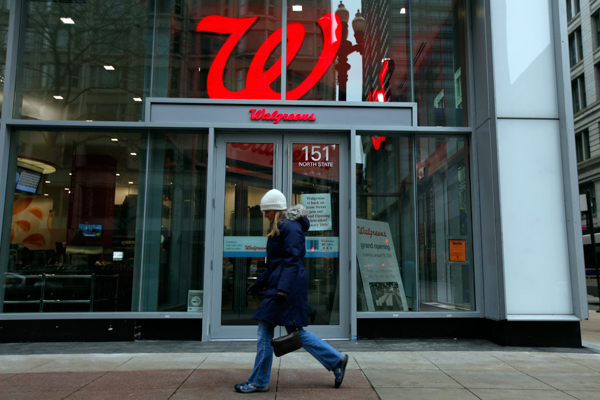
José M. Osorio/Chicago Tribune
I was clicking on something or another on Slate and saw something about THE FUTURE OF RETAIL by "Moneybox" columnist Matt Yglesias in the "most read" stories. Obviously, I had to know.
Now I've seen the future, and it's name is Walgreens. Specifically the new flagship Walgreens at the corner of 7th and H Northwest in the District of Columbia. It's a magical place that paints the way forward for retailers and, indeed, the entire American economy.
[snip]
The store is all about the use of technology. There's an ATM (of course) to replace your bank and a Redbox to replace your video store but also a futuristic soda fountain capable of dispensing any kind of Coca-Cola product.
Basically it's like the Walgreens at State and Randolph. Which isn't so much the future as the past. It's like Walgreens used to be—selling food, sody-pop, and as Adam Doster (welcome to the blog!) writes, booze:
In an interview from the same book (that Okrent excerpts), Walgreen’s son admits that any store fire nearly gave his dad a heart attack. “He wanted the fire department to get in as fast as possible,” he remembered, “because whenever they came in we’d always lose a case or two of liquor” from the back. On top of that, Al Capone, “like so many other Chicagoans … was a regular.”
People in comments are having trouble figuring out whether or not the Slate piece is a leg-pull ("Wawa has been offering most of those features for years… is this satire?").
While it is not entirely earnest, I think it also reflects that Washington D.C.—despite being the political capital of the free world and the only major city to ride out the recession with rents jumping and unemployment falling—is still a not-very-big city. There's a surprising lack of nice things, like an actual downtown, or trains that run past midnight on weekdays. A lot of people and employers in D.C. share my interests, so it always loomed as a future destination for me, despite having lots of the things I don't like about the South. And it lacks many of the things I do like—Southerners, for example.*
Walgreens might be the future of retail in D.C., bless their hearts. But they're like the places that have a mediocre selection of food, a smattering of alcohol, minimal-service banking, a pharmacy, and a Redbox—aka, chain grocery stores. (The touchscreen soda fountain of the future is entertaining until you realize its gimmick is combining flavors that don't exist for a reason, like lime ginger ale.)
There is one addition to the retail scene Walgreens makes: A nurse practitioner to diagnose and treat minor conditions. (CVS has had this for over a decade.) It's nice enough to have a convenient model for dead-simple illnesses even in a place that's lousy with primary care physicians, but this is the key:
Three segments have emerged as the major users: younger consumers, children, and (overlapping these two categories) consumers who report that they do not have a relationship with a PCP. Thirty percent of respondents reported having no PCP relationship, and 22 percent reported being uninsured at the time of their retail clinic visit.
Walgreens recently started treating patients with chronic illnesses, also something CVS has been doing for awhile. This includes conditions that can be more prevalent in underserved communities, like diabetes and asthma. If they can serve as a bridge to PCPs while providing basic and more convenient health maintenance, that might be the future—with some lime ginger ale on the side.
* I grew up in western Virginia. We have a chip on our collective shoulder about D.C.


